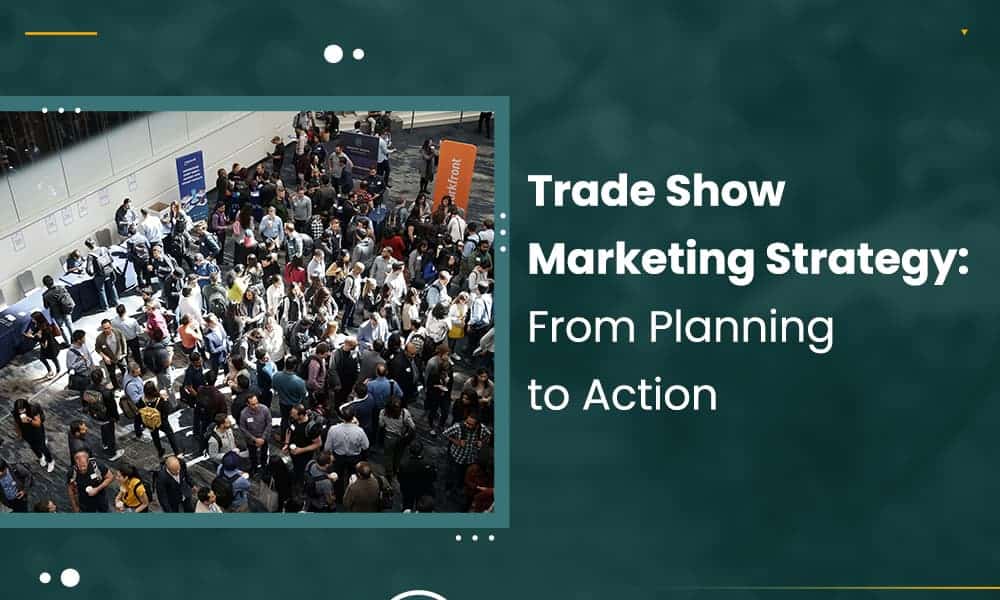With about 13,000 trade shows in the United States annually and roughly 11.5 million attendees (still below COVID numbers but showing signs of improvement), trade shows are big business.
If you don’t have a trade show marketing strategy in place, your event will be plagued by sagging attendance, low-quality sponsors, and a weak show that, overall, doesn’t motivate people to want to come back next year.
These trade show marketing strategies show what you need before, during, and after your trade show to make an impact.
Table of Contents
Pre-Trade Show Planning
Planning before your trade show sets up your event for success. You can determine which marketing tactics suit your event and the steps required to achieve them while your trade show is still in its early stages.
This should give you ample time to realize those marketing goals.
Here are the planning stages to implement.
- Set clear objectives
- Perform a target audience analysis
- Allocate your budget
- Select the right type
Set clear objectives
First, before you go any further, sit down with key stakeholders within your company to discuss your marketing objectives. Are you trying to build up hype around a product launch? Do you want to increase lead generation?
Whatever the answers, gauge where you are now and where you want to be. Then, determine an achievable goal.
For example, if you currently have 1,000 Facebook followers and want 10,000, you can get there eventually, but not in a week or two (unless you buy your followers, but I’m sure you know better than to do that).
Keep your goals realistic. Little bits of forward momentum are still momentum!
Perform a target audience analysis
Next, you have to know your audience. It’s impossible to put together the type of event they want to attend without understanding their needs and challenges, let alone market to them successfully.
A target audience analysis breaks down your audience by geographics, demographics, and psychographics. Based on those values, you can determine what your audience wants out of a trade show and how you can deliver.
If you have a global audience that is unable to attend your trade show in person, you may also consider hosting a virtual trade show to reach a broader audience.
Regarding your marketing campaign, you will have a clearer understanding of the marketing channels that resonate the most with your audience, whether social media marketing, email marketing, or SMS.
Allocate your budget smartly
With prices starting at $100 per square foot and upward of $500, your trade show spending will be in the five figures if your event space is in the three figures and six figures if you have a space that’s 1,000 square feet and up.
On top of that spending, you must leave room in your budget for marketing. The money for this usually comes from your income — you can allocate between 10% and 15% toward your campaign.
Select the right type of trade show
Trade shows come in various formats, including amusement and attraction, agriculture, restaurant/food industry, healthcare, arts and crafts, technology, and manufacturing industry trade shows.
Your trade show type should align with your industry and niche. If one type of event hasn’t panned out well for you based on historical audience data, consider a pivot to a trade show type that’s a better match.
Effective Trade Show Booth Design and Setup
Building your booth is one of the most important facets of trade show marketing. After all, you will have put a lot of time and money into promoting and advertising yourself; this is your chance for it all to pay off.
An attention-grabbing design is a must, so here are some strategies to help you achieve it.
Bigger can be better
Large, eye-catching displays that outsize anyone else’s at the trade show will naturally draw more attention than a smaller booth. Booth visitors will stream toward you all day, primarily out of curiosity.
However, it doesn’t matter what got them there; it’s just that they came. Once they do, you can razzle and dazzle them with the other strategies in this section.
Of course, remember that a large display comes at a price. You will need a budget almost as big as your trade show booth!
Throw them a curveball
If you can’t afford bigger booth space, think of how to innovate at the trade show. Perhaps you use this stage to introduce your latest ambitious product or service or create an interactive display that has people talking all day.
The less expected of you, the more attention-grabbing your booth can be.
Visualize your booth from multiple sides
You don’t need to cover 100% of your booth space; if anything, that’s a waste of money. If your booth is pushed against a wall, it doesn’t matter what’s on there, as no one will see it. That’s also the case if attendees can’t walk behind the booths.
However, the other side of your display is fair game. Don’t only look at your display from the front but also from other sides to consider how attendees might come upon it. Decorate accordingly, using attention-grabbing elements on all sides where people will be.
Get interactive with your events
An event-wide scavenger hunt, raffle, photo booth, webinar, contest or giveaway, virtual reality booth, trivia event, product demos, or interactive game will draw attention. The same goes for video walls displaying people’s faces, photos, or social media feeds (all with permission).
Use high-quality graphics
It’s worth paying extra for crystal-clear wraparound or stick-on graphics for your booth. Grainy, low-res imagery will confuse people, especially if they can’t even read your brand name.
Watch your graphic placement height
You can have graphical elements from top to bottom, but remember that anything below waist height is wasted. No one will spend that much effort to see what your brand is all about. If they can’t see the display while walking, it won’t resonate. Talk about wasted brand awareness!
Consider lighting carefully
Lighting is a major element of your booth. Different types of lighting can create entirely disparate moods, from bright and inviting to dark and dramatic. Get to know the type of lighting available for your booth and augment if necessary (and if it’s allowed).
Read also: The Tricks of Trade Marketing: 7 Strategies That Work
Trade Show Marketing Before the Event
Now, let’s get to the heart of the matter: marketing your event!
There’s no better time to start promoting your trade show with marketing, especially if it’s months away — often called pre-show marketing. This gives your event marketing efforts time to play out and pay off.
So, what tasks should you add to your to-do list as you begin your trade show marketing plans? Try these.
- Email marketing
- Direct mail
- Social media
- Teasers
- Networking
Email marketing
Begin generating signups to your email list as early as possible to increase attendance for the upcoming trade show, even if it’s a year away.
Here are some strategies to implement to increase the size of your email list:
- Publish high-quality and varied content, like blog posts, videos, eBooks, checklists, whitepapers, and webinars. You can use these as lead magnets.
- Get on social media and invite your audience to join your email list.
- Embed the email signup link in your professional email signature.
- Implement exit intent pop-ups to help those on the fence change their minds.
- Incorporate social proof in the form of positive reviews and testimonials to showcase the positive effect your products or services have.
- Add social sharing buttons to encourage more readers to share your content with their friends, family, and colleagues, who may subscribe.
Once you’ve built your email list, it’s up to you to keep the content interesting and engaging. Segment the newest signups and your other long-term contacts, separating them into groups by interest and pain point.
Produce tailored, interesting email content, and watch your send frequency. Emailing several times a week is expected of most businesses, but sending messages more than once a day (unless you’re having a flash sale) is extraneous.
Your emails should build excitement towards the trade show. Announce ticket on-sale dates and offer exclusive early-bird pricing to your subscribers.
Direct mail
Although traditional marketing methods are often put on the back burner in favor of digital measures, both still have their place. Promoting your trade show on the local market is wise unless it’s an all-digital event.
Direct mail can fill in the gaps that you missed with your email campaign. A simple pamphlet introducing your trade show, mentioning the date and time, and stating that tickets are on sale now is enough to whet your recipient’s appetite.
Social media
Social media will be one of your strongest digital marketing allies throughout the event, including before the trade show gets underway, during, and afterward.
For now, let’s talk about how you can use social media before the show launches.
From Facebook to Twitter, Instagram, and YouTube, social media is your stage to generate buzz about your trade show.
You can count until tickets go on sale, inspire curiosity with teasers, make mystery announcements (requiring users to check back later to see who or what it’s about), and otherwise get your social media followers just as hyped about your trade show as you are.
Take time to engage with your audience, responding to comments as you can and certainly keeping messages about your trade show from going unanswered.
Teasers
Social media isn’t the only place where a trade show teaser is appropriate. Your email newsletter and your website are two other places where you might consider dropping a teaser.
Networking
Don’t get burnt out on shaking hands before the trade show, but now is an especially good time to connect with your current network and expand it. Schedule as many meetings with potential partners or clients as you can, as you’ll only get busier as your event draws closer.
Make sure to tap into professional networks like LinkedIn, connecting with old contacts and newer ones.
Read also: Top Retail Marketing Strategies To Grow Your Business
At the Trade Show: Engaging Attendees
Your trade show marketing strategies paid off, as you have record-breaking attendance, more web traffic, more leads, and a booming email list.
You’re just getting started! Producing a five-star trade show will only increase the above results and lead to more conversions and sales. Here are some strategies for connecting meaningfully with your trade show attendees.
Staff training and engagement strategies
All staff should be trained a few months before the event to talk to potential customers. You might pitch products or services at your booth, but there’s a nuance to selling that your staff must know. If they come across too aggressively, word will get around, and your trade show booth will be ignored.
It might help to roleplay specific customer scenarios, so your team is ready to navigate.
Live demonstrations and presentations
Earlier, I briefly mentioned the value of live demonstrations. Let’s go a little bit deeper into that.
There’s hardly a better way to showcase the value of your products or services than through live presentations and demonstrations. Rather than just display it, let people try what you’re selling.
Free demos are popular because, well, they’re free. People also like to purchase products and services that have already proven useful and beneficial for them, which they can determine by trying out what you sell.
This is like taking a test drive. You get to feel how the car moves as smooth as butter and hear its purr. That kind of personal experience is critical for closing the deal.
Promotional giveaways and contests
Another great trade show marketing strategy to implement once your event is live is contests and giveaways. You could participate in the doorbuster, giving attendees a sample of what you bring. Yours could be their first experience at the event, shaping the rest of their day.
Make giveaways and contests easy to enter to encourage more people to join in. Your products or services should be the prize, but participating in the contest should be almost as fun as winning.
For instance, a trivia game or throwing hoops into a basketball net make joining in exciting. It doesn’t even matter as much if your attendees win.
Lead capture tactics
Trade show lead capture must be a priority. These days, many tools that cater to trade show hosts or participants eager to retrieve leads and begin qualifying them are out there. Leave some room in the budget for a good marketing software.
Here are some ways you can capture a lead’s contact information:
- As part of your email list, sign up before the trade show
- On social media
- During the trade show, during a contest or giveaway
Read also: 7 Secret Dealership Marketing Tactics By The Top Guys
Post-Trade Show Strategies
Congratulations on a successful trade show. Now that the event has concluded, the real work can begin.
Follow-up campaigns
For instance, you should start following up with the leads you’ve amassed between your pre-show and mid-show marketing.
You don’t have to send an email the day after to your new subscribers, but you don’t want to wait too long, either. Ideally, within a week of attending your event is good, and within the first 48 hours is better.
If you wait longer than a week, people could forget who you are and wonder why they signed up to your email list. You could be reported as spam.
Analyzing trade show performance
You might have felt your show was successful, but there’s only one way to be certain: to let the numbers do the talking. The following KPIs will tell you point-blank whether your trade show marketing strategies worked.
- Website traffic
- Social media followers
- Email subscriber rate
- Open rate
- Click-through rate
- Customer lifetime value
- Net Promoter Score
- Gross ticket sales
- Number of attendees
- Cost-to-revenue ratio
- Brand mentions
- Cost per lead
- Leads converted
- Number of qualified leads generated
- Repeat attendees
- Opportunities in the room
- Networking results
- Social media followers
- Social media engagement and mentions
- Number of meetings with potential clients
- Attendee engagement
- Number of sponsors
- Amount of media and press coverage
Read also: Creative Event Marketing Ideas to Get People Excited
Trade Show Marketing Examples
How else can you help you ideate your dream trade show marketing strategy? By showcasing the best of the best examples, of course.
Here are some booths, exhibits, and attractions that made a major impact at their respective events.
OC Ramps
As you probably guessed from the name, OC Ramps specializes in skate ramps. While they could have created a standard booth, they went above and beyond, incorporating a half-pipe, as seen here.

Although the half-pipe was empty when that photo was taken, it didn’t stay that way for long. All day, real skaters would use the half-pipe to demonstrate the durability and quality of the ramp. Attendees could also take photos holding a skateboard in front of the half-pipe. Radical!
Good Good
Does your trade show have height requirements for the booths? If so, you could feel hindered by the limitations. I can understand the frustration, but think outside the box for something truly incredible.
For instance, Good Good had a simple pop-up canopy tent at this trade event, yet it still got people visiting all day.
The reason it works is because of its gorgeous colors. There’s no way you can ignore a display like this.

Display Group
If you want to let your booth do all the talking, make it like Display Group did and add fantastical elements. The projector screen is already eye-catching enough. Combining that with the oversized polar bear statue, architectural posts, and neon lighting makes for an overall inventive display.

Read also: Beyond Basic Branding: How Integrated Marketing Helps
Wrapping Up
Devising a clearcut trade show marketing strategy is the key to elevating your attendance, increasing lead quality, converting more leads, and increasing sales.
Your marketing plans should begin before the event, continue during the trade show, and persist after connecting with those newly won leads.
EngageBay is an all-in-one marketing, sales, and customer support software for small businesses, startups, and solopreneurs. Sign up today or book a free demo with our experts.
